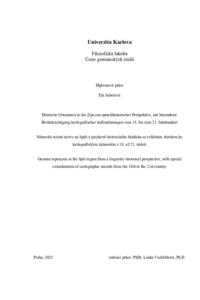Deutsche Ortsnamen in der Zips aus sprachhistorischer Perspektive, mit besonderer Berücksichtigung kartografischer Aufzeichnungen vom 18. bis zum 21. Jahrhundert.
Place names of the Spiš region from the diachronic point of view, with special attention to cartographic sources from the 18th to the 21th centuries.
Místní jména Spiše z historicko-lingvistické perspektivy, se zvláštním zřetelem ke kartografickým záznamům od 18. do 21. století.
diploma thesis (DEFENDED)

View/
Permanent link
http://hdl.handle.net/20.500.11956/200568Identifiers
Study Information System: 258889
Collections
- Kvalifikační práce [24330]
Author
Advisor
Referee
Šemelík, Martin
Faculty / Institute
Faculty of Arts
Discipline
Germánská a severoevropská studia: Germanistika
Department
Institute of Germanic Studies
Date of defense
16. 6. 2025
Publisher
Univerzita Karlova, Filozofická fakultaLanguage
German
Grade
Excellent
Keywords (Czech)
deutsche Sprache|Historiolinguistik|Onomastik|Zips|18.-21. Jahrhundert|německý jazyk|historická lingvistika|onomastika|Spiš|18.-21. stoletíKeywords (English)
German Language|Historical Linguistics|Onomastics|Spiš|18th-21th CenturiesTáto diplomová práca sa zaoberá analýzou nemeckých miestnych názvov v historickom regióne Spiš na území dnešného Slovenska. Cieľom bolo skombinovať jazykovedné prístupy: etymologickú, morfologickú a kartografickú analýzu, na základe systematicky zostaveného korpusu. Výsledky ukazujú, že miestne názvy nie sú len geografickými označeniami, ale nesú aj kultúrny, historický a spoločenský význam. Osobitná pozornosť sa venovala slovotvorbe, pričom najčastejším spôsobom slovotvorby bola kompozícia. Pôvod názvov je rozmanitý, od osobných mien, cez názvy svätcov až po prírodné prvky. Analýzu dopĺňali historické mapy z 18. až 21. storočia, ktoré dokumentujú jazykové zmeny v priebehu času. Práca potvrdzuje, že jazyk, história a regionálna identita sú navzájom úzko prepojené a toto prepojenie sa zreteľne odráža v toponymii regiónu Spiš. Klíčová slova: německý jazyk, historická lingvistika, onomastika, Spiš, 18.-21. století, místní názvy, etymologie, morfologie, jazykový kontakt, historické mapy, německá osídlení, jazykový vývoj.
This thesis focuses on the analysis of German place names in the historical region of Spiš, located in present-day Slovakia. The aim was to combine linguistic approaches such as etymology, morphology, and cartographic analysis based on a systematically compiled corpus. The results demonstrate that place names are not merely geographic labels, but carriers of cultural, historical and social significance. Particular attention was given to word-formation patterns, with compounding identified as the dominant morphological process. The origin of the names reflects diverse semantic fields such as personal names, saints, or landscape features. The analysis was complemented by historical maps from the 18th to the 21st century, which made diachronic changes and naming shifts visible. Overall, the thesis highlights the close interconnection between language, history, and regional identity as reflected in the toponymy of the Spiš region. Key words: German language, Historical linguistics, Onomastics, Spiš, 18th-21st centuries, Place names, Etymology, Morphology, Language contact, Historical maps, German settlements, Language change.
